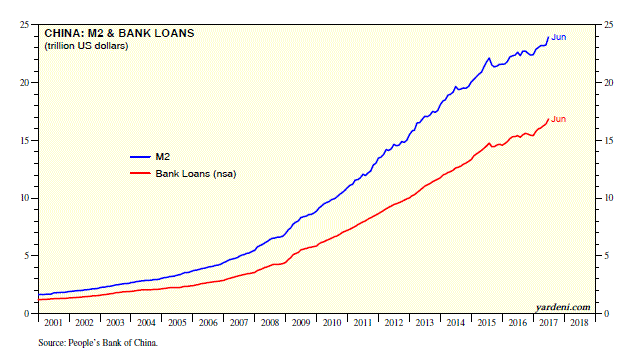China’s real GDP rose 6.9% y/y during Q2. During the quarter, it rose 6.7% (saar), which it’s been hovering around since the end of 2013. That’s a slowdown from the 10%-plus pace that was the norm in the years prior to the global financial crisis of 2008 and for a couple of years afterwards. Nevertheless, China’s growth rate is impressive compared to those in most other countries in the world. Even more impressive is how much credit it is taking to prop up China’s growth. Of course, this isn’t impressive in a positive way, since economic growth financed by excessive debt often ends badly.
Nevertheless, I am not among China’s doomsayers. I don’t want to bet against over a billion Chinese people who are mostly hard-working, entrepreneurial, aspirational, and materialistic—kind of like Americans. Instead of a big-bang implosion, China may follow the path of Japan. China is going down the same demographic road as Japan, with a rapidly aging population. Both countries have piled up lots of debt to boost growth. Both are financing their debt extravaganzas mostly internally. Both of their central banks are pumping massive amounts of liquidity into their economies. So, like Japan, China’s economic growth inevitably will slow as the population continues to age. All the injections of debt are akin to injections of Botox, which can make you look younger while you age and slow down. Consider the following:
(1) Social financing. Total social financing over the past 12 months through June rose by a record 19.2 trillion yuan, or a near-record US$2.8 trillion. It has been on a tear since the Chinese government pumped up the economy in response to the financial crisis of 2008. The country has become increasingly addicted to debt, and can’t seem to break the habit despite government officials’ previous assurances that will happen. It hasn’t happened so far because the government hasn’t figured out any other way (such as free-market capitalism) to boost growth. Since Premier Xi Jinping assumed command during November 2012, social financing has totaled a whopping $11.2 trillion, with bank loans up $6.4 trillion!
(2) Bank loans & M2. Bank loans are the largest component of social financing. Over the past 12 months through June, they rose by a record 13.2 yuan, or a record US$1.9 trillion. Astonishingly, bank loans have more than tripled since the end of 2008, soaring by 280% to a record $16.8 trillion during June.
The good news—I guess—is that all of this bank debt has been financed entirely by an increase in M2. So the Chinese owe it to themselves, similar to what has been happening in Japan for many years.
(3) Shadow banking system. Also mildly encouraging—I guess—is that the authorities seem to be making a bit of progress throttling back the shadow banking system. I estimate shadow banking activity by subtracting bank lending from total social financing. Doing so suggests that on a 12-month basis, the shadow banks accounted for a record 55.1% of social financing through May 2013. That percentage fell to a recent low of 25.1% through July 2016. It was back up to 31.3% in June of this year.
(4) Industrial production & trade. Just for fun, I compare the growth rates of China’s bank loans to industrial production and track the ratio of the former to the latter. The ratio of bank loans to industrial production confirms my concerns about China’s increasingly debt-financed growth. All that debt seems to be having a decreasing impact on boosting economic growth. The ratio was relatively stable around 100 from 2000-2008. Since then, it has risen sharply and persistently to a record 170 during June. The Chinese seem to be getting less and less output bang per yuan.
The good news is that China’s trade data (in yuan) has improved significantly since early last year, with both exports and imports near record highs in June. The y/y growth rates for these categories were strong at 16.9% and 22.6%. The exports data suggest that the global economy is growing solidly, though some of that may be due to the stimulus provided indirectly by China’s ongoing borrowing binge.
(5) Demographics. Weighing on China’s growth rate is its geriatric demographic profile. The country’s fertility rate dropped below the replacement rate of 2.1 children per woman during 1995, and is expected to remain below that level through the end of the century, according to UN projections. The growth rate of the population is projected to turn negative during 2033. The growth rate of the working-age population (WAP) already turned negative during 2016 and is expected to remain so through the end of the century—with WAP falling to 558 million from a peak of 1,015 million during 2015.


